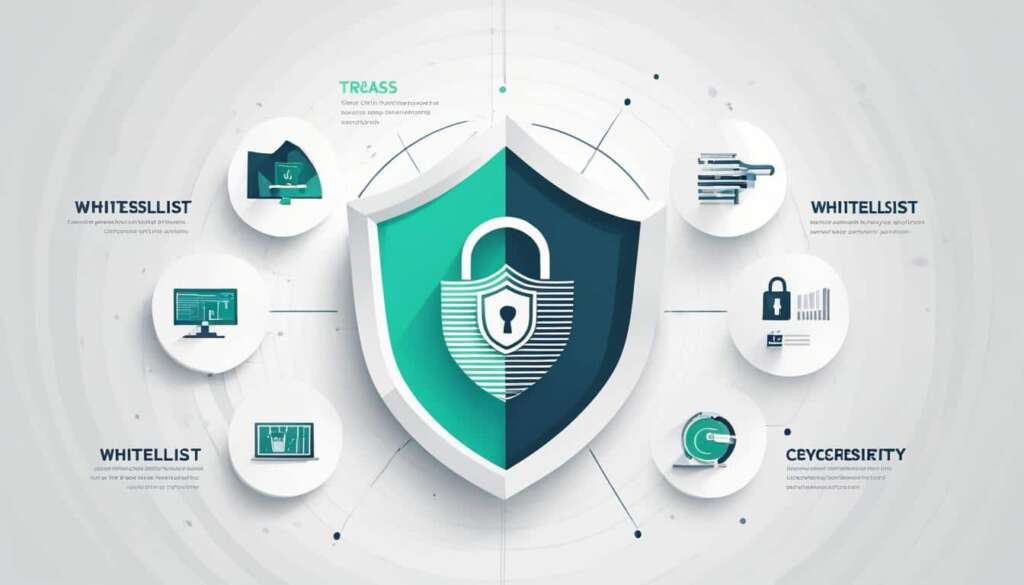Table of Contents
A whitelist, also known as an allowlist, is a cybersecurity strategy used by IT administrators to approve a list of email addresses, IP addresses, domain names, or applications while denying all others. It helps safeguard computers and networks from potential threats or inappropriate material.
IT administrators create a whitelist based on a strict policy set, which involves compiling a list of allowed sources, destinations, or applications. This list is applied to network appliances, desktops, server software, or operating systems.
The whitelist permits access to approved applications or services, while denying access to software or malicious code, noncompliant material, sensitive information leakage, and the use of shadow IT. Examples of whitelisting include email spam filters and access control lists.
Whitelisting is different from blacklisting, where applications or services are explicitly denied.
Best practices for whitelisting include documenting and categorizing whitelisted objects, being specific when creating a whitelist object, performing regular whitelist reviews, and applying whitelists efficiently.
How Does Whitelisting Work?
Whitelisting is a cybersecurity strategy that works by granting access permissions to approved applications, sources, or services while denying requests for anything that is not on the whitelist. IT administrators compile a list of allowed sources, destinations, or applications that users require access to, and then this list is applied to network appliances, desktops, server software, or operating systems. Once applied, the network device or server monitors user, device, or application requests and allows access only to whitelisted services. All other requests for software, malicious code, noncompliant material, sensitive information leakage, or shadow IT are denied. Whitelisting provides a strict policy that ensures only approved applications or services can be accessed, enhancing cybersecurity and protecting against potential threats.
Benefits of Whitelisting
Whitelisting offers several benefits for brands and creators. For brands, whitelisting allows them to create dark posts, which are paid Facebook and Instagram ads that do not show up on the influencer’s feeds but appear as ads to the targeted audience. This gives brands full control over targeting and helps achieve their media objectives, such as reach, brand lift, page views, or purchases.
Whitelisting also enables brands to test and learn. By comparing influencer performance within different audiences, brands can gain valuable insights and understanding of the return on investment (ROI) in influencer campaigns. This helps brands make data-driven decisions and optimize their marketing budgets effectively.
For creators, whitelisting provides extended reach for their content. By partnering with brands and being whitelisted, creators can reach a wider audience and increase their visibility. Whitelisting also helps reduce audience fatigue by ensuring that ads featuring creators’ content are targeted to specific audiences, resulting in more engaging and relevant content experiences.
Moreover, whitelisting opens up new opportunities for creators to earn money. By allowing brands to use their content in ads, creators can generate additional income streams without having to create the ads themselves. This frees up their time and resources to focus on creating high-quality content and further expanding their business growth and brand awareness.
Different Methods of Whitelisting Influencers
When it comes to whitelisting influencers, there are several approaches brands can take. One method is the manual process, where influencers create a Facebook Business Manager account and connect it to their Facebook and Instagram profiles. From there, they manually assign partners with advertising access, a task that requires close collaboration between the brand and the influencer. While this method is effective, it can be time-consuming.
Alternatively, brands can utilize automated tools like Lumanu to simplify the influencer whitelisting process. Lumanu streamlines the process by allowing influencers to grant usage rights, provide whitelisting access, and share audience data with just one click. The beauty of Lumanu is that it automates the process, eliminating the need for a Facebook Business Manager.
Another option is the Branded Content Tool, a feature introduced by Facebook and Instagram. This tool allows influencers to tag brand partners in their posts, making it easier for brands to include their partners in the post. However, it’s important to note that the Branded Content Tool does have limitations. For example, it lacks a call-to-action button, has limited copy changes, and does not offer amplification for Instagram Stories.
Once influencers have been whitelisted, brands can create dark posts using influencer identities in their Facebook Ads Manager. This enables brands to run paid ads that target specific audiences, ensuring maximum reach and effectiveness.
FAQ
What is a whitelist?
A whitelist, also known as an allowlist, is a cybersecurity strategy used by IT administrators to approve a list of email addresses, IP addresses, domain names, or applications while denying all others. It helps safeguard computers and networks from potential threats or inappropriate material.
How does whitelisting work?
Whitelisting works by granting access permissions to approved applications, sources, or services while denying requests for anything that is not on the whitelist. IT administrators compile a list of allowed sources, destinations, or applications that users require access to, and then this list is applied to network appliances, desktops, server software, or operating systems. Once applied, the network device or server monitors user, device, or application requests and allows access only to whitelisted services. All other requests for software, malicious code, noncompliant material, sensitive information leakage, or shadow IT are denied. Whitelisting provides a strict policy that ensures only approved applications or services can be accessed, enhancing cybersecurity and protecting against potential threats.
What are the benefits of whitelisting?
Whitelisting offers several benefits for brands and creators. For brands, whitelisting allows them to create dark posts, which are paid Facebook and Instagram ads that do not show up on the influencer’s feeds but appear as ads to the targeted audience. This gives brands full control over targeting and helps achieve their media objectives, such as reach, brand lift, page views, or purchases. Whitelisting also enables brands to test and learn by comparing influencer performance within audiences and understanding the return on investment in influencer campaigns. For creators, whitelisting provides extended reach for their content, reduces audience fatigue, and opens new opportunities for earning money. It allows creators to focus on creating content without having to create the ads themselves, and it increases their business growth and brand awareness.
What are the different methods of whitelisting influencers?
There are different methods to whitelist influencers. The manual process involves the influencer creating a Facebook Business Manager, connecting their Facebook, and Instagram accounts, and assigning partners manually. This process can be time-consuming and requires close collaboration between the brand and the influencer. Another method is using an automated tool like Lumanu, which simplifies the whitelisting process by allowing influencers to grant usage rights, provide whitelisting access, and share audience data in one click. Lumanu automates the process and eliminates the need for a Facebook Business Manager. The Branded Content Tool, introduced by Facebook and Instagram, allows influencers to tag brand partners on their posts, simplifying the process for inclusion of brand partners in the post. However, it has limitations like no call-to-action button, limited copy changes, and no amplification for Instagram Stories. After whitelisting influencers, brands can create dark posts using influencer identities in their Facebook Ads Manager and run paid ads to target specific audiences.












